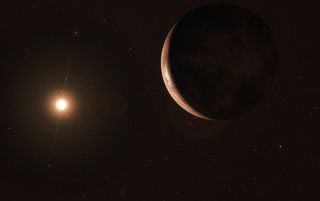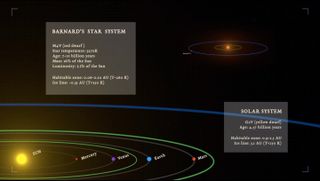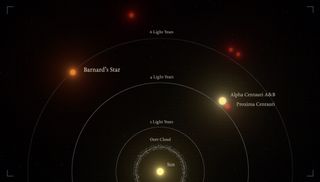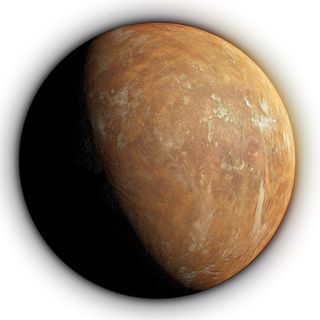Barnard's Star b: What We Know About Nearby 'Super-Earth' Planet Candidate
Introduction

On Nov. 14, 2018, astronomers announced the detection of a planet candidate circling Barnard's Star, which lies just 6 light-years from the sun. Only the three stars in the Alpha Centauri system, located about 4.3 light-years from us, are closer solar neighbors.
Here's what you should know about Barnard's Star and its potential planet, which still needs to be confirmed by follow-up observations or analysis.
Spotting signs of gravitational tugs

Astronomers detected Barnard's Star b via the "radial velocity" method, noting subtle shifts in starlight caused when the gravitational pull of the planet jostled its host star this way and that. It was not an easy detection; never before had such a small planet in such a distant orbit been spotted using the radial velocity method. The research team analyzed 20 years' worth of observations, which were made by seven different instruments.
Barnard's Star b lies about 0.4 astronomical units (AU) from its host star — just 40 percent of the Earth-sun distance, which is 1 AU (93 million miles, or 150 million kilometers). The planet completes one lap every 233 Earth days.
Fast mover

Barnard's Star currently lies in the constellation Ophiuchus (the serpent bearer) and is visible from both the Northern and Southern hemispheres with a small telescope.
But it's on the move. Barnard's Star boasts the fastest apparent motion of any star, traveling about the width of the full moon across our sky every 180 years or so. In about 10,000 years, Barnard's Star will be the closest star to the sun, at just 3.8 light-years away.
A tempting target

For decades, astronomers, aerospace engineers and sci-fi fans have speculated that Barnard's Star could host planets.
In the 1970s, for example, the British Interplanetary Society's Project Daedalus proposed using fusion rockets to propel an uncrewed spacecraft to the Barnard's Star system, in part to study up-close any worlds that may reside there.
A nearby red dwarf

Barnard's Star is a red dwarf about one-sixth as massive as Earth's sun and just 3 percent as luminous. Astronomers think Barnard's Star may be about 10 billion years old — twice as old as our sun.
An icy super-Earth

Because Barnard's Star is so dim, things get very cold out in the exoplanet's neighborhood. Astronomers estimate Barnard's Star b's surface temperature to be about minus 275 degrees Fahrenheit (minus 170 degrees Celsius).
Barnard's Star b is about 3.2 times more massive than our home planet, making it a "super-Earth" — a class of worlds significantly larger than Earth but smaller than ice giants such as Neptune. Super-Earths are among the most common planets in the Milky Way, but we don't have any in our solar system.
A shadowy world

Astronomers have no idea what Barnard's Star b actually looks like. But its surface is probably suffused in dim, orangish light during the day.
Exoplanets common in Earth's neighborhood

If this exoplanet ends up being confirmed, as seems very likely, Barnard's Star b won't be the nearest exoplanet to Earth. That distinction goes to Proxima b, which orbits the red dwarf Proxima Centauri, part of the three-star Alpha Centauri system. Proxima Centauri is the closest star to Earth's sun, at just 4.2 light-years away.
Proxima b is a roughly Earth-mass world that may be capable of supporting life as we know it. Together, the discoveries of Proxima b and Barnard's Star b suggest that smallish exoplanets are common in Earth's neck of the cosmic woods, just as they are in the broader Milky Way galaxy.
Mike Wall's book about the search for alien life, "Out There" (Grand Central Publishing, 2018; illustrated by Karl Tate), is out now. Follow him on Twitter @michaeldwall. Follow us @Spacedotcom or Facebook.
Join our Space Forums to keep talking space on the latest missions, night sky and more! And if you have a news tip, correction or comment, let us know at: community@space.com.
Get the Space.com Newsletter
Breaking space news, the latest updates on rocket launches, skywatching events and more!

Michael Wall is a Senior Space Writer with Space.com and joined the team in 2010. He primarily covers exoplanets, spaceflight and military space, but has been known to dabble in the space art beat. His book about the search for alien life, "Out There," was published on Nov. 13, 2018. Before becoming a science writer, Michael worked as a herpetologist and wildlife biologist. He has a Ph.D. in evolutionary biology from the University of Sydney, Australia, a bachelor's degree from the University of Arizona, and a graduate certificate in science writing from the University of California, Santa Cruz. To find out what his latest project is, you can follow Michael on Twitter.
